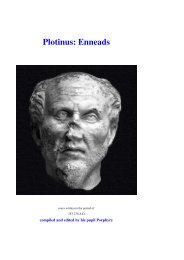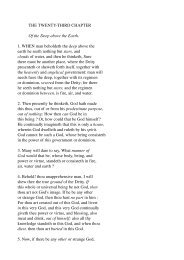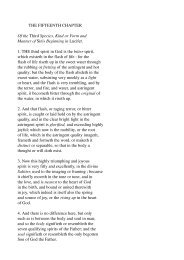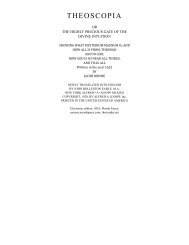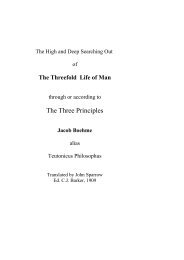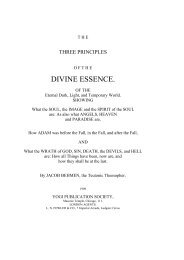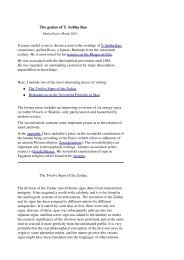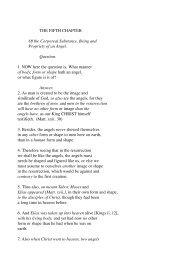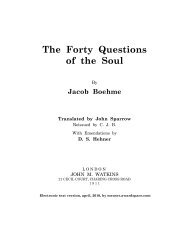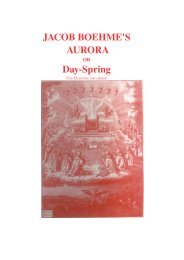Gerald Massey's Lectures - Society in evolution - Awardspace
Gerald Massey's Lectures - Society in evolution - Awardspace
Gerald Massey's Lectures - Society in evolution - Awardspace
Create successful ePaper yourself
Turn your PDF publications into a flip-book with our unique Google optimized e-Paper software.
the Repa, the Heir-Apparent, the Horus, the Buddha, Krishna or the Christ. Two sets of<br />
the seven may be tabulated <strong>in</strong> their Egyptian and H<strong>in</strong>du shapes and compared as follows:-<br />
INDIAN. EGYPTIAN.<br />
1. Rupa, body, or element of form 1. Kha, body.<br />
2. Prana, or Jiva, the breath of life 2. Ba, the soul of breath.<br />
3.Astral body 3. Khabs, the shade.<br />
4. Manus, or Intelligence 4. Akhu, Intelligence or Perception<br />
5. Kama-Rupa, or animal soul 5. Seb, ancestral soul.<br />
6. Buddhi, or spiritual soul 6. Putah, the first <strong>in</strong>tellectual father.<br />
7. Atma, pure spirit 7. Atmu, a div<strong>in</strong>e, or eternal soul.<br />
Primitive man naturally observed from the first that he was brought forth by the mother,<br />
formed of flesh, made from her blood; that is the mystical water, or matter of life, and the<br />
red earth of mythology. This primal element was represented by the Great Mother of all<br />
flesh; and the first soul was accord<strong>in</strong>gly derived from the blood, the mystical parent of<br />
Life. Thus, <strong>in</strong> the Mangaian account of Creation, the Great Mother, Vari, is said to make<br />
the first man from pieces of her own flesh! Flesh be<strong>in</strong>g blood that has taken form. "Some,<br />
<strong>in</strong>deed," says Hermes, "misled by nature, mistook the blood for the soul;" that is, they<br />
took it so, to beg<strong>in</strong> with; and such was the nature of the human soul No. 1. This soul of<br />
blood is identified <strong>in</strong> Genesis ix. 4 and 5. Blood is the Adamic soul! From the Mother<br />
source came the red earth of the Adamic or primary creation, whence the Rabb<strong>in</strong>s<br />
sometimes call Adam the "Blood of the world!" In the Semitic languages, Assyrian and<br />
Hebrew, Adam signified "Blood"--simply blood, as the red. It was thought at one time<br />
that two primal races of men were alluded to <strong>in</strong> the Cuneiform Texts, under the names of<br />
Adamu and Sarku; but it is now known that these names signify the two pr<strong>in</strong>ciples of<br />
female matter and male spirit, the H<strong>in</strong>du perusha.<br />
At this primitive stage beg<strong>in</strong> the legends with which we have been so pitiably beguiled,<br />
or so profoundly perplexed!<br />
In the first account of the creation of man, <strong>in</strong> the Hebrew Genesis, he is formed <strong>in</strong> the<br />
image of the Elohim, who were the seven primal elemental powers, that became celestial<br />
as the keepers of time <strong>in</strong> Heaven--<strong>in</strong> their second phase--and ultimately the seven<br />
Planetary spirits. At that early stage of sociology, man descended from the mother alone!<br />
In the second creation (for there are two), the woman is derived from the male as<br />
progenitor. The first is born of blood, the second of bone, a type of mascul<strong>in</strong>e substance.<br />
And these two sources, female and male, supply the two doctr<strong>in</strong>al types to Paul when he<br />
says, "As <strong>in</strong> Adam (the flesh-man) all men die, even so <strong>in</strong> Christ (the spirit-man) shall all<br />
be made alive!" Here the true <strong>in</strong>terpretation cannot be obta<strong>in</strong>ed without the aid of the<br />
primitive physiology; it does not depend upon any fulfillment of fable as fact <strong>in</strong> later<br />
history, but on the adaptation of the mythical types to convey a mystical mean<strong>in</strong>g <strong>in</strong> what<br />
are called "mysteries," that were very simple <strong>in</strong> their primal phase--which phase is the<br />
object of our present search.<br />
The Psalmist refers to this Adamic man when he says, "Put not your trust <strong>in</strong> the son of<br />
man; his breath goeth forth, he returneth to his earth. In that very day his purposes<br />
perish." The antithesis to this was the Son of God, the second Adam, the man from<br />
heaven, the Christ, or immortal spirit; <strong>in</strong> short, a later type of the human soul! The first<br />
Adam represented the man, or creation of the seven souls, and the seven Elohim, whence<br />
it was said, <strong>in</strong> the Semitic Legends, that his head only reached up to the seventh heaven.<br />
The second Adam, or the Christ, atta<strong>in</strong>s the eighth heaven, as the height; or, he comes,<br />
later on, to represent the ten-fold heaven as the Adam Kadmon of the Kabbalists.<br />
The Tahitians, whose Great Mother is named Eve (or Ivi), have the same physiological<br />
myth! They say that the first men were formed of Araea, or red earth, and on this they<br />
lived until bread was made--bread be<strong>in</strong>g typical of corn, corn of seed, i.e., male source.



